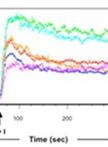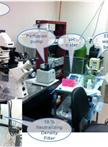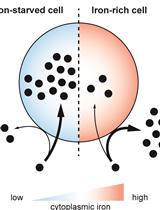- EN - English
- CN - 中文
Sodium Current Measurements in HEK293 Cells
HEK293细胞中的钠电流测定
发布: 2013年08月20日第3卷第16期 DOI: 10.21769/BioProtoc.858 浏览次数: 14539
评审: Anonymous reviewer(s)
Abstract
This protocol is used to measure sodium currents from heterologously transfected cells lines, such as HEK293 cells. Standard whole cell patch clamp technique is used to assess ion channel function. This protocol has been used to study cardiac type Nav1.5 sodium channel, and in particular to compare wild-type and mutant channels related to Brugada Syndrome (BrS). Mutations related to BrS provoke a loss of function of the cardiac sodium channel. This is evidenced by a reduction of sodium current density and/or alterations of the activation or inactivation kinetic parameters, such as a slow recovery from inactivation. These effects could explain the alteration of the cardiac action potential that leads to the characteristic ST elevation observed in the electrocardiogram of the Brugada Syndrome patients. This protocol, with some variations, is suitable for studying other cardiac arrhythmias related to alterations in the cardiac type sodium channel function as well as for studying other voltage-dependent sodium channels.
Materials and Reagents
- Human embryonic kidney HEK293 cells (Health Protection Agency Culture Collections, catalog number: 96121229 )
- Vector/s: mammalian expression vectors harboring the cDNA of interest (i.e. pcDNA3 + SCN5A)
- Dulbecco’s Modified Eagle’s Medium (DMEM) (Sigma-Aldrich, catalog number: D6546 )
- Fetal Bovine Serum (Sigma-Aldrich, catalog number: F4135 )
- Penicillin-streptavidin (Life Technologies, Gibco®, catalog number: 15140-122 )
- GlutaMAXTM (Life Technologies, Gibco®, catalog number: 35050-038 )
- 0.05% Trypsin-EDTA (Life Technologies, Gibco®, catalog number: 25300-062 )
- Dulbecco’s Phosphate Buffered Saline (Sigma-Aldrich, catalog number: D8662 )
- GeneCellinTM Transfection Reagent (BioCellChallenge, catalog number: GC-1000 )
- Opti-MEM® Reduced Serum Media + GlutaMAXTM (Life Technologies, Gibco®, catalog number: 31985-062 )
- Sticky wax in bars (Cera de Reus, catalog number: 25005001 )
- Sodium chloride (NaCl) (Sigma-Aldrich)
- Potassium chloride (KCl) (Sigma-Aldrich)
- Cesium chloride (CsCl) (Sigma-Aldrich)
- Calcium chloride (CaCl2) (Sigma-Aldrich)
- Magnesium chloride (MgCl2) (Sigma-Aldrich)
- N-2-hydroxyethylpiperazine-N’-2-ethanesulfonic acid (HEPES) (Sigma-Aldrich)
- Ethylene glycol-bis (2-amino-ethylether)-N,N,N’,N’-tetra-acetic acid (EGTA) (Sigma-Aldrich)
- Adenosine 5′-triphosphate magnesium salt (ATP-Mg2+) (Sigma-Aldrich)
- Sodium hydroxide (NaOH) (Sigma-Aldrich)
- Cesium hydroxide (CsOH) (Sigma-Aldrich)
- Glucose (Sigma-Aldrich)
- Bath solution (see Recipes)
- Pipette solution (see Recipes)
Equipment
- Inverted microscope Nikon Eclipse Ti fitted for epifluorescence (Nikon Instruments Inc.)
- Glass capillary PC-10 Puller (Narishige International USA Inc.)
- Micromanipulator MP-285 (Sutter Instrument Co.)
- Vapor pressure Osmometer VAPOR 5520 (Wescor Inc.)
- Axopatch 200B Capacitor Feedback Patch Clamp Amplifier (Molecular Devices)
- Axon Digidata 1440A Data Acquisition System (Molecular Devices)
- CO2 incubator
- Nunclon® cell culture dishes 35 x 10 mm (Sigma-Aldrich, catalog number: D7804 )
- Glass capillaries (Brand GmbH + CO KG, catalog number: 7493-21 )
Software
- pCLAMP 10.2 Electrophysiology Data Acquisition and Analysis Software (Molecular Devices)
- OriginPro 8 software (OriginLab Corporation)
Procedure
文章信息
版权信息
© 2013 The Authors; exclusive licensee Bio-protocol LLC.
如何引用
Riuró, H., Tarradas, A., Selga, E., Brugada, R., Scornik, F. and Pérez, G. (2013). Sodium Current Measurements in HEK293 Cells. Bio-protocol 3(16): e858. DOI: 10.21769/BioProtoc.858.
分类
细胞生物学 > 基于细胞的分析方法 > 离子分析 > 钠
您对这篇实验方法有问题吗?
在此处发布您的问题,我们将邀请本文作者来回答。同时,我们会将您的问题发布到Bio-protocol Exchange,以便寻求社区成员的帮助。
Share
Bluesky
X
Copy link












